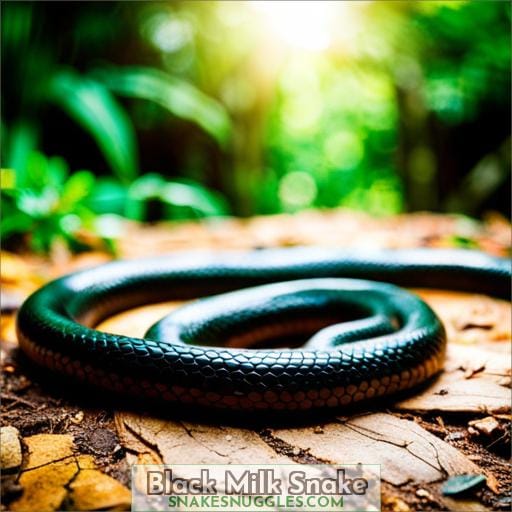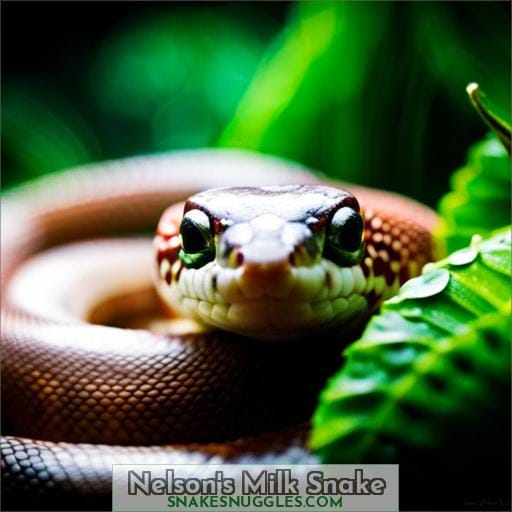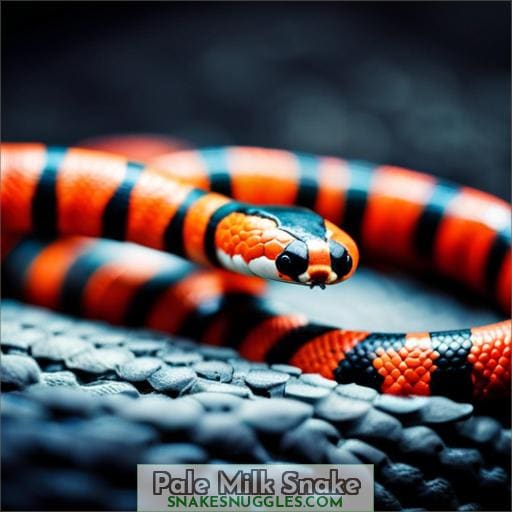This site is supported by our readers. We may earn a commission, at no cost to you, if you purchase through links.
 Dive into the captivating realm of milk snakes as your guide to an enchanting world of serpentine companionship.
Dive into the captivating realm of milk snakes as your guide to an enchanting world of serpentine companionship.
These slithering wonders, ideal for pet enthusiasts, possess vibrant personalities that beckon exploration. Imagine welcoming these serpents into your life, each species boasting its unique tapestry of colors and patterns, akin to a symphony of hues woven into their very scales.
Within this realm, the Eastern Milk Snake emerges with its mesmerizing gray and reddish-brown spotted pattern, an artwork etched by nature. Delve into the care and handling of these captivating creatures, a perfect gateway for those new to the allure of serpentine companionship.
Delight in discovering the varied companions that await: the enigmatic Black Milk Snake, the vivid Honduran Milk Snake, the striking Nelson’s Milk Snake, the ethereal Pale Milk Snake, the charming Pueblan Milk Snake, and the resplendent Red Milk Snake.
Embark on a journey of understanding, intimacy, and liberation as we unveil the secrets of these beguiling creatures, offering an invitation to appreciate the beauty and wonder of the world of milk snakes as cherished pets.
Table Of Contents
Key Takeaways
- Milk snakes exhibit a variety of captivating species, each showcasing unique colors and patterns that resemble a woven symphony.
- These species include the Eastern Milk Snake, Black Milk Snake, Honduran Milk Snake, and Nelson’s Milk Snake. Each of these snakes possesses distinctive coloration and markings.
- Milk snakes prove to be an ideal choice for pet enthusiasts with vibrant personalities. Moreover, they stand as suitable options for beginners due to their passive nature.
- Proper care encompasses providing the appropriate enclosure, maintaining optimal temperature, and ensuring proper feeding. Additionally, employing effective handling techniques can contribute to the formation of an intimate bond.
Types of Milk Snakes for Pets
Imagine holding in your hands a vibrant and beautifully patterned reptile, easily manageable even for beginners. These friendly creatures come in various subspecies, each with unique colors, sizes, and behaviors.
This offers you a wide array of choices to find the perfect companion for your reptile journey.
Milk snake varieties include the Eastern type, with its gray and reddish-brown spotted pattern. There’s also the Black milk snake, known for its bold blackish hue. The Honduran milk snake boasts bright bands of black, red, and orange-yellow.
Setting up suitable enclosures and understanding their feeding habits contributes to their captivity longevity—up to 20 years. With their docile nature and striking appearances, milk snakes stand as excellent choices for a pet snake.
Eastern Milk Snake
Venturing into the realm of the Eastern Milk Snake, one encounters a distinct gray and reddish-brown spotted pattern that stretches across its 2 to 4-foot length. These gentle serpents, spread throughout the United States, captivate reptile enthusiasts with their amiable demeanor.
Upon delving into their care and handling, it becomes evident that Eastern Milk Snakes flourish in cooler temperatures, rendering them a versatile and relatively easy-to-care-for choice of pet.
Appearance and Behavior
Picture yourself holding one of these captivating creatures in your hands, feeling their vibrant scales brushing against your skin as they move with docile curiosity. Their striking appearance, resembling the allure of coral snakes, adds a touch of wonder to every interaction, making them ideal companions for those seeking an enchanting reptilian bond.
-
Nocturnal Habits: These snakes are most active during the night. They display their fascinating behaviors under the cover of darkness.
-
Vibrant Patterns: Species like the red milk snake and the black milk snake exhibit vivid colors and patterns, testifying to nature’s artistry.
-
Temperament Characteristics: Milk snakes are known for their passive nature. They are easy to handle and make excellent pets for beginners.
-
Prey Constrictions and Noxious Mimicry: These snakes utilize constriction to overpower their prey. Additionally, their noxious mimicry of coral snakes serves as a defense against potential predators.
Care and Handling
To properly care for the Eastern Milk Snake, ensure you provide the appropriate enclosure, maintain the right temperature, and stick to a consistent feeding schedule. It’s essential to understand its feeding habits, enclosure setup needs, and temperature requirements.
Handling techniques should be done carefully, as it may become nervous if handled incorrectly. Trust-building exercises can help create an intimate bond between humans and snake husbandry, making caring easier with time.
Temperature needs vary depending on the subspecies, so understanding this prior to purchase is critical for long-term success in owning any type of milk snake.
Black Milk Snake
If you’re considering a Black Milk Snake as your reptile companion, you’ll be intrigued to know that these sleek creatures can reach lengths of 4 to 6 feet, making them quite striking additions to your collection.
Black Milk Snakes possess unique characteristics that set them apart:
-
Morph Variety: They can evolve to be entirely black or blackish-brown, giving them a mysterious and captivating appearance.
-
Nonvenomous Nature: Like all milk snakes, the Black Milk Snake is nonvenomous, making it safe to handle.
-
Nervous Temperament: Although they can be nervous, regular handling can help them become more comfortable over time.
-
Adaptable Care: Proper care involves providing the right enclosure, temperature, and feeding regimen.
-
Size Considerations: With a length of 4 to 6 feet, they require ample space in their enclosure.
With their enigmatic coloration and manageable temperament, Black Milk Snakes offer reptile enthusiasts the opportunity to experience the allure of nonvenomous snakes up close.
Honduran Milk Snake
Imagine holding in your hands a vibrant creature from the tropical lands of Central America. The Honduran Milk Snake, with its striking bands of black, red, and orange-yellow, invites awe and fascination as it gracefully coils around your fingers.
If you’re a reptile novice, the Honduran Milk Snake might pique your interest. Although nervous, they can become more accepting with time and feeding.
Captive breeding has made these color morphs more accessible, ranging from vivid to subtle.
As you navigate the realm of snake ownership, the Honduran Milk Snake promises a captivating journey of intimacy and understanding.
Nelson’s Milk Snake
Moving from the Honduran Milk Snake, let’s explore the intriguing realm of Nelson’s Milk Snake.
Unique Patterns: This subspecies boasts a striking appearance, with its pale yellowish-white base color adorned by bold black and red bands. This creates a captivating contrast.
Behavior Traits: Nelson’s Milk Snakes are renowned for their colorful yet docile nature, making them favorites among experienced snake handlers.
Size Variability: These snakes grow to over 3 feet in length, showcasing a variability in size akin to other milk snake subspecies.
Captive Care Tips: To ensure their well-being, replicate their natural habitat by providing a suitable enclosure with proper temperature and humidity levels.
Habitat: In the wild, Nelson’s subspecies thrives in grasslands, forests, and rocky areas, primarily found in North America. For snake enthusiasts seeking a visually striking and well-behaved companion, Nelson’s Milk Snake offers an alluring choice.
Pale Milk Snake
With its ethereal and delicate appearance, the Pale Milk Snake has an almost otherworldly charm.
As a subspecies of milk snake, these gentle giants exhibit a distinctive dusty white base color adorned with mesmerizing red markings. They range from 18 to 24 inches in length, placing them among the smaller milk snake varieties.
Their calm demeanor and tolerance for handling, as seen in beginner-friendly snake breeds, make them an excellent choice for both beginners and experienced snake keepers. Pale Milk Snakes are known for their calm disposition, often being more tolerant of handling compared to their counterparts.
This species prefers cooler temperatures, reminiscent of their natural Eastern habitat. Ensuring a proper enclosure, temperature, and feeding schedule will guarantee the well-being of these captivating creatures.
Pueblan Milk Snake
Exploring the realm of Pueblan Milk Snakes, you’ll be captivated by their mesmerizing albino shades, which resemble warm apricot hues intertwined with vibrant tangerine tones.
Caring for Pueblan Milk Snakes requires attention to their specific needs:
-
Albino Coloration: The striking albino appearance stands as a hallmark of Pueblan Milk Snakes, making them truly eye-catching.
-
Temperature Needs: It’s crucial to maintain an appropriate temperature gradient in their enclosure for their well-being, ensuring they have warm and cooler areas.
-
Handling Tips: Initially, Pueblan Milk Snakes can be nervous, but with regular and gentle handling, they become more accustomed to human interaction.
-
Frozen Rodents Diet: These snakes show a preference for a diet of frozen rodents, primarily mice, to meet their nutritional needs.
-
Variability in Appetite: Similar to other milk snake subspecies, the appetite of Pueblan Milk Snakes can vary. Therefore, it’s important to gauge their hunger levels.
Embracing the enchanting world of Pueblan Milk Snakes brings not only the joy of their captivating appearance but also the responsibility of providing proper care for these unique creatures.
Red Milk Snake
Delving into the vibrant realm of these captivating creatures, the Red Milk Snake stands out with its distinctive widely distributed hue. It’s marked by striking bands of red, black, and white along its snout, measuring three feet or more in length.
Known for its captivating appearance, this subspecies exhibits a beautiful contrast of colors that intrigues and enchants snake enthusiasts. Originating from the southeastern United States, including areas like Florida and Georgia, the Red Milk Snake thrives in various habitats.
When it comes to diet, it possesses a hearty appetite for small rodents, with a particular preference for mice. While these snakes may initially be shy and nervous, they tend to become more accepting with time and consistent feeding.
Conclusion
Wrapping up this reptilian journey, you’ve explored the diverse world of milk snakes – those mesmerizing marvels. Each type, from the Eastern’s endearing docility to the Black’s bold demeanor, holds a unique allure.
These vivacious vipers, when properly nurtured, prove to be ideal companions. With vibrant personalities and manageable care requirements, milk snakes make captivating and colorful additions to any pet-loving household.
So, whether you’re captivated by the elegance of the Eastern or the Pueblan’s pastels, milk snakes offer a spectrum of snake-sational choices for aspiring herpetologists and curious companions alike.











